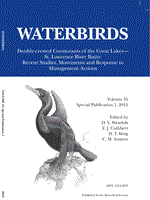Binational colonial waterbird censuses were formally initiated in the Great Lakes in 1976, and have been repeated every eight to ten years. Although population estimates from these efforts are good trend indicators for some species, including Double-crested Cormorant (Phalacrocorax auritus), information is generally not available to examine population changes between census periods, especially at a local scale. The study examined shortterm, annual population changes and distribution patterns of cormorants in the Beaver Archipelago of northern Lake Michigan between 2000 and 2007, and compared these data to decadal trends. Although no control efforts were underway between 2000 and 2006, an egg-oiling and culling program was initiated in 2007, after the completion of the decadal census. The peak number of breeders was documented in 1997, with lower population sizes between 2000 and 2006; however, in 2007, the population again approached peak numbers, suggesting that immigration from other regions occurred. Overall, yearly surveys determined that individual colonies showed great plasticity in breeding population size, with some colonies forming and others disappearing; some changes were due to environmental factors, while others indicate interactions with other species, human disturbance, and perhaps management activities in other areas of the Great Lakes. Yearly population estimates indicate that the long-term trends are probably captured with decadal colonial waterbird surveys, but the dynamic nature of cormorant populations is not. In addition, presence of yearly variation in the breeding population size of an “unmanaged” population emphasizes the importance of closely monitoring species that are managed aggressively.
How to translate text using browser tools
1 December 2012
Comparing Decadal Census Trends and Yearly Variation in Abundance and Distribution of Breeding Double-Crested Cormorants: Importance of Monitoring a Managed Species
Nancy E. Seefelt
ACCESS THE FULL ARTICLE

Waterbirds
Vol. 35 • No. sp1
December 2012
Vol. 35 • No. sp1
December 2012
Beaver Archipelago
colony disturbance
cormorant
decadal census
Lake Michigan
Phalacrocorax auritus
population controls




